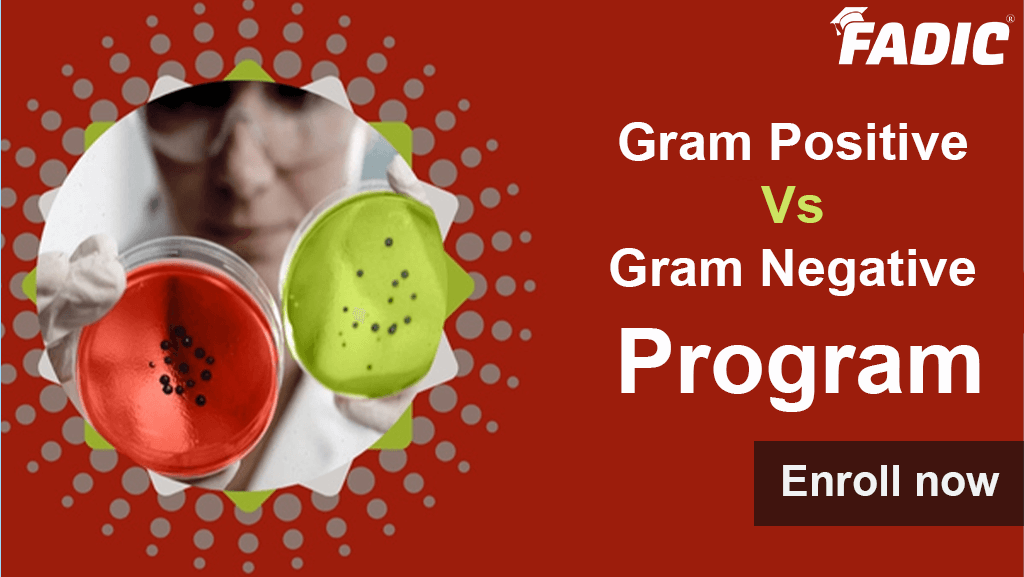
Why Enroll in this Course?
Enroll in the Gram Positive vs. Gram Negative Program to gain comprehensive microbiology knowledge, hands-on experience, and cutting-edge insights. Enhance your career, learn from experts, and address global health challenges like antimicrobial resistance. This flexible course integrates theory with practical application, ensuring you are well-equipped for professional excellence.
Overview
Gram Positive Vs Gram Negative Program

Welcome to the comprehensive “Gram Positive vs. Gram Negative Program,” designed to provide in-depth knowledge and experience in microbiology, antimicrobial stewardship, and diagnostic techniques.
This five-week course is structured to enhance your understanding of bacterial classifications, their clinical significance, and the latest advancements in microbiological diagnostics and treatment strategies.
Week 1: Foundations of Microbiology
- – Microbiology Introduction: Begin your journey with a solid foundation in microbiology, understanding the basics and significance of studying microorganisms.
- – Gram-Positive vs. Gram-Negative: Learn the critical differences between gram-positive and gram-negative bacteria, their structural characteristics, and their implications in healthcare.
- – MIC Interpretation: Master the interpretation of Minimum Inhibitory Concentrations (MIC) to determine the effectiveness of antimicrobial agents.
- – Workshop 1: Engage in interactive sessions to apply your knowledge in real-world scenarios.
- – Antimicrobial Stewardship Algorithms: Explore algorithms that guide the appropriate use of antimicrobials to combat resistance.
Week 2: Diagnostic Techniques and Resources
- – Antibiogram Interpretation: Understand how to interpret antibiograms to guide effective antibiotic therapy.
- – Rapid Diagnostic Tests: Discover the latest rapid diagnostic tests and their role in identifying bacterial infections.
- – Microbiology Resources: Familiarize yourself with essential microbiology resources for ongoing learning and reference.
- – Summarized Bacterial Types: Review and summarize different bacterial types for quick identification.
- – Microbiology & Pharmacy Education: Integrate microbiology knowledge with pharmacy practices for a holistic approach to patient care.
- – Workshop 2: Participate in practical sessions to reinforce diagnostic skills.
Week 3: Focus on Gram-Positive Bacteria
- – Staphylococcus: Dive deep into the characteristics, pathogenicity, and treatment of Staphylococcus species.
- – Streptococcus: Study the various Streptococcus species, their clinical manifestations, and management.
- – Enterococcus: Learn about Enterococcus species and their significance in nosocomial infections.
- – Workshop 3: Apply your knowledge in case studies and problem-solving exercises focused on gram-positive bacteria.
Week 4: Focus on Gram-Negative Bacteria
- – Acinetobacter: Explore the challenges in treating Acinetobacter infections and their resistance mechanisms.
- – Pseudomonas: Understand the complexities of Pseudomonas aeruginosa infections and their treatment.
- – Stenotrophomonas: Study Stenotrophomonas maltophilia, a rising concern in hospital settings.
- – E. coli: Gain insights into Escherichia coli, its various strains, and clinical significance.
- – Klebsiella: Learn about Klebsiella species and their role in healthcare-associated infections.
- – Enterobacter: Study Enterobacter species and their impact on patient health.
- – Serratia: Understand Serratia species and their clinical presentations.
- – Proteus: Learn about Proteus species and their unique characteristics.
- – Haemophilus influenzae, Moraxella catarrhalis, Neisseria meningitidis: Explore these bacteria and their implications in respiratory and systemic infections.
- – Workshop 4: Engage in hands-on activities to solidify your understanding of gram-negative bacteria.
Week 5: Specialized Bacteria and Resistance
- – Chlamydia, Mycoplasma, & Legionella: Study these atypical bacteria and their role in respiratory infections.
- – Anaerobes Organisms: Learn about anaerobic bacteria and their unique treatment challenges.
- – Multidrug-Resistant Organisms: Understand the mechanisms of multidrug resistance and strategies to combat them.
- – Workshop 5: Conclude the program with practical sessions focused on managing infections caused by multidrug-resistant organisms.
Join us in this immersive program to advance your knowledge and skills in microbiology, ensuring you are well-equipped to tackle the challenges of infectious diseases in clinical settings.
Enroll today and take the first step towards becoming a proficient microbiology professional.

If you have any inquiries, please contact WhatsApp.

-
Week 1
- Microbiology Introduction
- Gram-Positive Vs. Gram-Negative
- MIC Interpretation
- Workshop 1
- Antimicrobial Stewardship Algorithms
-
Week 2
- Antibiogram Interpretation
- Rapid Diagnostic Tests
- Microbiology Resources
- Summarized Bacterial Types
- Microbiology & Pharmacy Education
- Workshop 2
-
Week 3
- Staphylococcus
- Streptococcus
- Enterococcus
- Workshop 3
-
Week 4
- Acinetobacter
- Pseudomonas
- Stenotrophomonas
- E. coli
- Klebsiella
- Enterobacter
- Serratia
- Proteus
- Haemophilus Influenzae, Moraxella catarrhlis, Neisseria Meningitidis
- Workshop 4
-
Week 5
- Chlamydia, Mycoplasma, & Legionella
- Anaerobes Organisms
- Multidrug-Resistant Organisms
- Workshop 5

 Log in
Log in Sign up
Sign up

